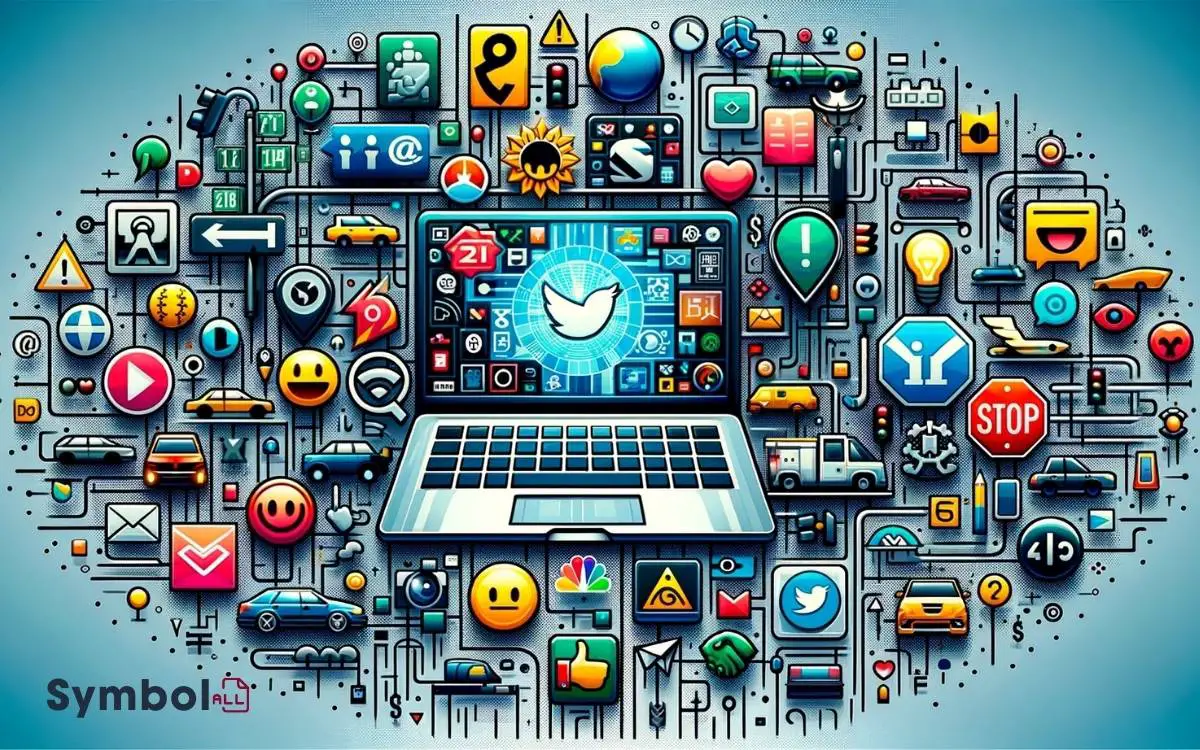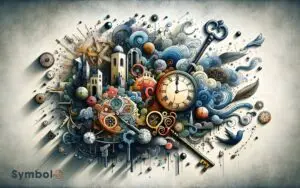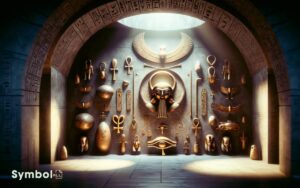How Can Symbols Be Used in the Real World? Explains!
In your daily journey, you’re constantly interacting with symbols. They’re not just logos or icons representing companies; they tap into your subconscious, evoking emotions and forging connections.
You see, symbols aren’t merely visuals; they’re tools that companies craft to weave into your life, shaping your perceptions and fostering a sense of community.
They guide you through physical and digital landscapes, offering a universal language that breaks through cultural barriers. Symbols carry cultural stories, reflecting identities and values.
Whether it’s exploring a website with intuitive icons or expressing emotions through emojis, you’re engaging in a world rich with symbolic communication. Investigating further, you’ll uncover the intricate tapestry of symbols that narrate the human experience.

Key Takeaways
Branding and Identity
In the domain of branding, symbols serve as the cornerstone, instantly conveying a company’s identity and values to the public. You’re immersed in a world where logos and icons aren’t just artistic expressions, but strategic tools that encapsulate the essence of a brand.
They’re not mere visuals; they’re a language in their own right, speaking directly to your subconscious, evoking emotions, and building connections.
This intricate dance of symbolism isn’t accidental. Companies meticulously craft these symbols to resonate with you, embedding themselves into the fabric of your daily life.
They’re omnipresent, from the clothes you wear to the technology you use, each symbol narrating a story, shaping perceptions, and fostering a sense of belonging.
Understanding this symbolic landscape offers you a deeper insight into the consumer culture that surrounds you.
Navigational Aids
Symbols don’t just shape brands; they also guide your journey, acting as directional aids that help you traverse the intricate landscapes of both physical and digital worlds. Whether it’s a stop sign on the road or an arrow button in an app interface, these symbols serve as universal languages that simplify complexity. Like a variable used for changing quantities in mathematical equations, these icons adapt to different contexts, providing clarity and consistency in uncertain environments. Ultimately, they bridge the gap between intention and understanding, making the world more navigable for everyone.
From the ubiquitous arrows pointing your way through airport terminals to the tiny icons leading you through app interfaces, symbols serve as the silent sentinels of direction and information.
In these roles, they transcend mere decoration, embodying a universal language that speaks across cultural and linguistic barriers. You’ve likely followed the trail of breadcrumbs left by symbols on a hiking path or relied on the subtle cues within an app to find your desired function.
These symbols, though small, play a vital role in steering the complex networks of our daily lives, proving that effective communication doesn’t always require words.
Cultural Significance
Beyond exploring us through physical and digital terrains, symbols also carry deep cultural significance, shaping and reflecting the identities of communities around the globe.
From the intricate patterns woven into the fabrics of indigenous tribes to the universally recognized peace sign, symbols act as silent narrators of societal values, beliefs, and histories.
They’re not just markers of cultural identity but also powerful tools for communicating shared experiences and ideals across generations.
As you investigate further into the symbols surrounding you, you’ll find that they’re not arbitrary. Each is embedded with stories, conveying not just individual meanings but also collective memories.
They foster a sense of belonging, connecting people through a visual language that transcends words, and highlighting the rich tapestry of human culture.
Educational Tools
You’ve observed symbols in cultural contexts, but their power extends into education, shaping how you learn and remember.
Symbols in classrooms and educational games not only make learning more engaging but also enhance retention by connecting abstract ideas to visual cues.
This shift towards visual aids and symbolic play in learning environments mirrors broader societal changes, reflecting an evolving understanding of knowledge transmission and cognition.
Enhancing Learning Retention
Incorporating visual symbols as educational tools can greatly enhance students’ ability to retain and recall information. When you’re traversing the intricate landscape of learning, symbols serve as anchors, tying abstract concepts to tangible representations.
This connection isn’t just superficial; it’s rooted in how the human brain processes and stores information.
Symbols, with their inherent ability to convey meaning succinctly, cut through the noise of textual overload. They create mental shortcuts that enhance recall.
This isn’t merely theoretical. Ethnographic studies in diverse educational settings have shown that when learners associate symbols with specific pieces of knowledge, they’re more likely to remember and apply that knowledge effectively.
It’s a tribute to the power of visual learning, transcending cultural and linguistic barriers to open up a universal language of understanding.
Visual Aids in Classrooms
Building on the effectiveness of symbols in enhancing learning retention, visual aids in classrooms serve as powerful educational tools, greatly impacting students’ comprehension and engagement.
These tools bridge the gap between abstract concepts and tangible understanding, allowing you to grasp complicated ideas through visual representation.
| Type | Function | Impact |
|---|---|---|
| Charts | Organize Information | Enhances Memory Recall |
| Diagrams | Simplify Complex Processes | Improves Understanding |
| Maps | Provide Spatial Context | Increases Geographical Awareness |
Incorporating these aids into lessons not only enriches your learning experience but also nurtures a more inclusive environment.
Diverse learners, including those who might struggle with traditional text-based instruction, find visual aids a lifeline, making learning accessible and engaging.
Through these tools, you’re not just memorizing; you’re connecting with the material on a deeper level, fostering a richer, more nuanced understanding of the world around you.
Symbols in Educational Games
Delving into the domain of educational games reveals how symbols serve as essential tools for enhancing learning through interactive engagement.
You’ll find that symbols, ranging from simple shapes to complex icons, aren’t just visual aids but are imbued with meanings that transcend language barriers, making education accessible to a broader audience.
This use of symbols in educational games facilitates a unique form of communication, where abstract concepts and instructions are conveyed without reliance on text, enabling even pre-literate children to participate in learning activities.
Through gameplay, symbols become deeply ingrained in the learner’s cognitive framework, promoting memory retention and understanding.
Analyzing their application, it’s clear that symbols in educational games aren’t mere decoration but pivotal elements that transform abstract ideas into tangible learning experiences.
Political Activism
Symbols wield powerful influence in political activism, serving as rallying points that encapsulate complex ideologies into recognizable icons.
You’ve seen them, perhaps without fully grasping their depth fists raised in solidarity, peace signs, or even specific colors tied to a cause. These aren’t mere images or trends; they’re the essence of movements, distilled into forms that cross linguistic and cultural barriers.
They bind communities, broadcasting a shared narrative without a word spoken. In your march, your protest, or your social media, these symbols become your voice, your identity. They’re not static; they evolve, reflecting the dynamic nature of political discourse.
From historical emblems to impromptu creations, they tell a story of struggle, resilience, and sometimes, triumph.
It’s a visual language, where understanding grows through context, often becoming as iconic as the movements they represent.
Digital Communication
In your daily interactions online, you’ve likely noticed how emojis add depth to your text messages, making emotions more palpable.
Hashtags, on the other hand, serve as beacons, guiding you through the vast sea of digital content to find exactly what you’re looking for.
Meanwhile, icons stand as universal signposts, ensuring you can navigate digital interfaces with ease, transcending language barriers.
Emojis Enhance Emotional Expression
Emojis, by embedding emotion into text, greatly enhance the way we express feelings in digital communication. In the absence of facial expressions and tone of voice, emojis serve as vital cues to understanding the emotional context behind the words you read.
They add a layer of clarity, reducing the risk of misinterpretation in our daily digital interactions.
| Emoji | Emotional Expression |
|---|---|
| 😂 | Laughter |
| ❤️ | Love |
| 😢 | Sadness |
| 😡 | Anger |
This table exemplifies how emojis serve as a bridge between digital text and human emotion, making our virtual conversations more nuanced and emotionally rich.
They are not just playful icons but a sophisticated language that enhances the depth of our digital dialogues.
Hashtags Streamline Content Discovery
As a tool for exploring the vast sea of digital content, hashtags efficiently guide your search towards relevant topics and communities.
Originating as a method to categorize messages on digital platforms, hashtags have evolved into a cultural and communicative phenomenon.
They serve as beacons, illuminating paths to niches and conversations that resonate with your interests or needs. By appending a simple ‘#’ to a keyword, you’re instantly connected to a global discussion, bypassing the clutter of unrelated information.
This system fosters a unique form of discovery, where serendipitous connections and insights emerge from the structured chaos of online discourse.
Essentially, hashtags aren’t just tools for navigation but are also the threads that weave the fabric of digital culture, enabling collective engagement and the sharing of perspectives across diverse digital landscapes.
Icons Simplify Interface Navigation
Exploring the digital landscape, you’ll find that icons serve as intuitive guides, streamlining your interaction with complex interfaces by distilling functions into universally recognizable symbols.
In this digital age, where information overflow is the norm, icons cut through the clutter, offering a visual shorthand that transcends language barriers. They’re not just decorative elements; they’re cultural artifacts, embodying the collective understanding of their function within digital environments.
When you tap a magnifying glass icon, you’re engaging with a global consensus that this symbol means search. This semiotic efficiency enables you to navigate the web and various applications with ease, making digital spaces more accessible and user-friendly.
Icons, essentially, are the lingua franca of the digital landscape, facilitating an intuitive interaction between you and the vast digital universe.
Conclusion
In wrapping up, it’s fascinating to observe how symbols permeate our lives. A striking statistic reveals that over 80% of the global population recognizes the McDonald’s Golden Arches, underscoring the profound impact of symbols in branding.
This ethnographic lens illuminates symbols not just as mere representations, but as pivotal elements shaping cultural narratives, guiding behaviors, and fostering community identity.
They’re not just markers on a map or logos on a billboard; they’re the language of our collective human experience, deeply embedded in the fabric of society.






